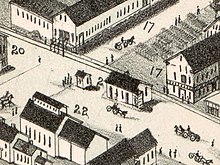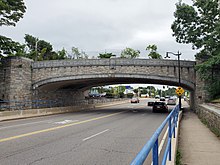Norwood Depot
Norwood Depot | |||||||||||||||||
|---|---|---|---|---|---|---|---|---|---|---|---|---|---|---|---|---|---|
 An inbound train arriving at Norwood Depot in 2012 | |||||||||||||||||
| General information | |||||||||||||||||
| Location | 4 Hill Street Norwood, Massachusetts | ||||||||||||||||
| Coordinates | 42°11′47″N 71°11′48″W / 42.1963°N 71.1968°W | ||||||||||||||||
| Line(s) | Franklin Branch | ||||||||||||||||
| Platforms | 2 side platforms | ||||||||||||||||
| Tracks | 2 | ||||||||||||||||
| Construction | |||||||||||||||||
| Parking | 219 spaces ($2.00 fee) | ||||||||||||||||
| Accessible | Yes | ||||||||||||||||
| Other information | |||||||||||||||||
| Fare zone | 3 | ||||||||||||||||
| History | |||||||||||||||||
| Opened | April 23, 1849 | ||||||||||||||||
| Rebuilt | 1977, 1992 | ||||||||||||||||
| Previous names | South Dedham, Nahatan, Norwood[1] | ||||||||||||||||
| Passengers | |||||||||||||||||
| 2018 | 285 (weekday average boardings)[2] | ||||||||||||||||
| Services | |||||||||||||||||
| |||||||||||||||||
| |||||||||||||||||
| Location | |||||||||||||||||
 | |||||||||||||||||
Norwood Depot is an MBTA Commuter Rail Franklin/Foxboro Line station located in downtown Norwood, Massachusetts. The station has two side platforms serving the two tracks of the Franklin Branch, each with a mini-high section for accessibility. The Norfolk County Railroad opened through South Dedham (now Norwood) in 1849, with a station at the modern location. It was renamed Norwood in 1872. The line came under control of the New York, New Haven and Hartford Railroad in 1895. The Massachusetts Bay Transportation Authority (MBTA) began subsidizing service in 1966 and purchased the line in 1973. Under the MBTA, renovations to the station were made around 1977 and 1992.
Station design
Norwood Depot is located in downtown Norwood, about 0.2 miles (0.3 km) northeast of Norwood Common. The two-track Franklin Branch, used by the Franklin/Foxboro Line service, runs approximately north–south through Norwood. The station has two low-level
History
19th century

The Norfolk County Railroad opened from Dedham to Walpole on April 23, 1849. South Dedham station (also called Nahatan), located at Railroad Avenue, was originally the only station in what is now Norwood (then part of Dedham).[1][6] Dedham Middle station (now Norwood Central) was added around 1852.[6] The station was renamed Norwood in 1872 when Norwood separated from Dedham.[7] The railroad went through several mergers, eventually becoming part of the New York and New England Railroad (NY&NE) in 1875.[6] Double track was extended from Islington through Norwood to Walpole in 1873–1881.[6] The station building was a one-story wooden structure on the east side of the tracks.[8][9]
Norwood Central station and Norwood Depot are located just 0.5 miles (0.8 km) apart.[1] In March 1891, the NY&NE petitioned the Massachusetts Board of Railroad Commissioners for permission to consolidate the two stations and to eliminate grade crossings nearby. The station consolidation had been opposed in a town vote two months earlier.[10][11] The board approved the railroad's petition on June 25, 1891.[12] By November 1892, the Railroad Avenue grade crossing was planned for elimination, along with three others in Norwood. However, the railroad objected to bearing 65% of the costs as laid out in an 1890 state law, and challenged the law in court.[13]
On February 15, 1892, the
In June 1894, the issue of station consolidation again went before the state board.[16] The commissioners approved the replacement of the two stations with a single station between Day and Vernon Streets.[17] The New Haven acquired control of the NY&NE through its subsidiary New England Railroad on September 1, 1895, and leased the line as its Midland Division effective July 1, 1898.[6] With both lines through Norwood under its control, the New Haven moved forward with some of the grade crossing eliminations. The crossings at Guild Street and Washington Street were eliminated in 1896–97.[18] By 1898, the New Haven planned to quadruple-track and grade-separate the line between Norwood Central and Boston, but this was never completed.[3][19]
In December 1897, a local business association appeared before the Massachusetts Supreme Judicial Court seeking the railroad to comply with the 1891 order and build a combined station.[20] A bill was put forward in the state legislature for the same purpose in March 1898.[21] The stations were never consolidated, though a new station building was constructed by the railroad at Norwood Central in 1899.[18]
20th century

By 1930, the Railroad Avenue grade crossing was controversially expected to be replaced by a new underpass at Nahatan Street, about 900 feet (270 m) to the south.[22] The underpass was opened in 1935, but the grade crossing remained open.[3][23] Service on the line was gradually reduced during the 20th century. The single daily round trip on the Wrentham Branch was discontinued on July 17, 1938, as part of a massive station closure.[24] The station building was demolished in the 20th century.[25] Norwood station was served only by local trains; intercity service stopped at Norwood Central station instead.[26]
The newly formed
References
- ^ ISBN 9780942147124.
- ^ a b Central Transportation Planning Staff (2019). "2018 Commuter Rail Counts". Massachusetts Bay Transportation Authority.
- ^ a b c Held, Patrick R. (2010). "Massachusetts Bay Colony Railroad Track Charts" (PDF). Johns Hopkins Association for Computing Machinery. p. 41. Archived from the original (PDF) on October 8, 2013.
- ^ Godwin, Ariel (April 27, 2011). "Inventory of Park-and-Ride Lots at MBTA Facilities". Boston Region Metropolitan Planning Organization.
- ^ "Norwood Depot". Massachusetts Bay Transportation Authority. Retrieved February 11, 2022.
- ^ ISBN 9780685412947.
- ^ Norwood, one of the newest and most progressive towns in Massachusetts. Ambrose Bros., Printers. 1906. p. 7 – via Internet Archive.
- ^ Sanborn Fire Insurance Map from Norwood, Norfolk County, Massachusetts. Sanborn Map Company. August 1892. p. 4.
- ISBN 9780738590226.
- ^ "Norwood's Grievance". Boston Globe. March 13, 1891. p. 7 – via Newspapers.com.
- ^ "Many Grade Crossings". Boston Globe. March 18, 1891. p. 6 – via Newspapers.com.
- ^ "Old Fight Renewed". Boston Globe. December 28, 1897. p. 5 – via Newspapers.com.
- ^ "Norwood Grade Crossing". Boston Globe. November 4, 1892. p. 2 – via Newspapers.com.
- ^ "Dedham to North Attleboro". Boston Globe. February 14, 1892. p. 6 – via Newspapers.com.
- ^ "Hitched on to Boston". Boston Globe. February 15, 1892. p. 8 – via Newspapers.com.
- ^ "Norwood's Three Depots". Boston Globe. June 12, 1894. p. 4 – via Newspapers.com.
- ^ "One Station for Norwood". Boston Globe. June 30, 1894. p. 3 – via Newspapers.com.
- ^ a b Tolles, Bryant Franklin Jr. (1973). Norwood: the centennial history of a Massachusetts town. Norwood Centennial Committee. pp. 126–131.
- ^ "Hay-Making Day". Boston Globe. September 2, 1898. p. 9 – via Newspapers.com.
- ^ "Old Fight Renewed". Boston Globe. December 28, 1897. p. 5 – via Newspapers.com.
- ^ "Want a New Station". Boston Globe. March 8, 1898. p. 4 – via Newspapers.com.
- ^ "Norwood". Boston Globe. June 21, 1930. p. 6 – via Newspapers.com.
- ^ Carolan, Jane (1988). "Historic Structure Inventory Form: Nahatan Street Railroad Bridge (Milepost #14.53)". MBTA Historical Property Survey, Phase II. McGinley Hart & Associates – via Massachusetts Cultural Resource Information System.
- ^ "Train service alibi for lateness today". Boston Globe. July 18, 1938. p. 2 – via Newspapers.com.

- ISBN 9780942147087.
- ^ "Table 18: Waterbury–Hartford–Putnam–Boston". The Scenic Shoreline Route Serving New York and New England. New York, New Haven and Hartford Railroad. April 24, 1955. p. 30 – via Wikimedia Commons.
- ^ a b Belcher, Jonathan. "Changes to Transit Service in the MBTA district" (PDF). Boston Street Railway Association.
- ^ 1977 Annual Report. Massachusetts Bay Transportation Authority. 1977. p. 15 – via Internet Archive.
- ^ Transportation Map, Massachusetts Bay Transportation Authority, Fall 1976 – via Wikimedia Commons
- ^ T system map, Massachusetts Bay Transportation Authority, 1978 – via Wikimedia Commons
- ^ MBTA : ACCESS; The Guide to Accessible Services and Facilities. Massachusetts Bay Transportation Authority. June 1992. p. 15 – via Internet Archive.
